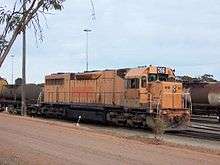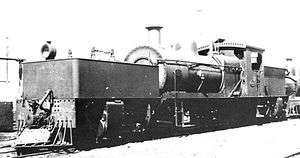WAGR L class (diesel)
| Western Australian Government Railways L Class | |||||||||||||||||||||||||||||||||||
|---|---|---|---|---|---|---|---|---|---|---|---|---|---|---|---|---|---|---|---|---|---|---|---|---|---|---|---|---|---|---|---|---|---|---|---|
|
L268, in its unique Westrail experimental blue livery, at Leighton yard. | |||||||||||||||||||||||||||||||||||
| |||||||||||||||||||||||||||||||||||
| |||||||||||||||||||||||||||||||||||
| |||||||||||||||||||||||||||||||||||
| |||||||||||||||||||||||||||||||||||
The L Class are a class of diesel locomotives built by Clyde Engineering, Granville and Eagle Farm for the Western Australian Government Railways between 1967 and 1973.
History
With the 657-kilometre (408 mi) Eastern Goldfields Railway between Perth and Kalgoorlie being converted to standard gauge, the Western Australian Government Railways started to take delivery of 23 Electro Motive Diesel GT26C locomotives from Clyde Engineering in October 1967.[1] The design was based on the EMD SD40 reduced in height to fit within the Australian loading gauge. At the time they were comfortably the largest and heaviest diesel locomotive operated by a government operator.[2]
All were delivered from Sydney via Melbourne and Adelaide, necessitating them being placed on broad gauge bogies for the journey between Dynon and Port Pirie.[2]
They entered service hauling iron ore trains from Koolyanobbing to Kwinana and the Indian Pacific. However they were quickly removed from passenger trains after it was realised the damage they could cause to the track at higher speeds.[2]
In 1972 Comalco purchased two locomotives of the same design for use on its 19.5-kilometre (12.1 mi) line at its bauxite mine in Weipa. These were built with an extra 11 tonnes (11 long tons; 12 short tons) of ballast for increased adhesion. In 1973 the Western Australian Government Railways took delivery of a further two, funded by Western Mining Corporation as part of the building of a nickel mine at Mount Windarra. All four were built by Clyde Engineering's Eagle Farm factory.[2]
In 1983 three were leased to V/Line to haul services on the standard gauge Melbourne to Albury line.[3] One even operated through to Sydney in May 1984.[4]
In 1994 following the purchase of GML10, Comalco's R1001 was sent to Clyde Engineering, Kelso for overhaul.[5] Upon its return in August 1994, R1002 was sold to Westrail and placed in service as LW276.[2]
Following the delivery of the Q class locomotives in 1997, many were withdrawn with those remaining in service relegated to trailing locomotive status.[6]
In July 1998, seven were sold to Australian Transport Network. After being overhauled by National Railway Equipment Company, Whyalla, four were placed in service by ATN Access hauling grain trains in southern New South Wales and Victoria. Three were included in the sale of Australian Transport Network to Pacific National in February 2004 while the fourth along with the three unused examples along with one of the operational units were sold to Rail Technical Services, Dynon who resold them to QR National subsidiaries Interail and Australian Railroad Group for use in New South Wales.[2]

The remainder were included in the sale of Westrail to Australian Railroad Group in December 2000. All were included in the sale of Australian Railroad Group's Western Australian operations to QR National in June 2006. After being stored for some years, the Pacific National-owned L's were scrapped in 2015.
All of the locomotives now under the control of Aurizon have been renumbered as the 3100 class.[7][8][9][10] Those fitted with Q-Tron traction control have had the "LQ" prefix applied, those with ZTR traction control "LZ". Some were transferred to New South Wales to haul trains from the Manildra Group's flour mills at Gunnedah, Manildra and Narrandera to Bomaderry from 2003 until 2008.[2]
In 2011 Comalco sold R1001 to Australian Locolease who placed it in service as L277 and leased it to El Zorro to operate grain trains in Victoria.
Models of the L Class have been produced in HO scale by two companies. Haskell Co Taiwan and Southern Rail Models.
Class list
| Key: | In Service | Withdrawn | Preserved | Converted | Unknown | Scrapped |
|---|
| Serial number | Date Built | Original Road Number | Renumbered As | Name | Current/Last Owner | Status |
|---|---|---|---|---|---|---|
| 67-541 | October 27th, 1967 | L251 | - | Thunderbird 1 | Pacific National | Scrapped, May 5th, 2015 (Werris Creek) |
| 67-542 | November 1967 | L252 | LZ3101 | Kurra Kurraka | Aurizon | Scrapped, June 2016 (Casino) |
| 67-543 | December 1967 | L253 | LZ3119 | - | Aurizon | Stored, October 2014 (Avon Yard) |
| 67-544 | January 1968 | L254 | - | Enterprise NCC 1701 | Pacific National | Scrapped after an engine fire, November 4th, 2016 (Cardiff Locomotive Workshops) |
| 67-545 | February 1968 | L255 | LZ3105 | - | Aurizon | Stored, October 2014 (Avon Yard) |
| 67-546 | March 1968 | L256 | LZ3106 | - | Aurizon | Stored, January 12th, 2018 (Avon Yard) |
| 68-547 | March 1968 | L257 | 3102 | Wagiman | J&P Metals | Empty shell at J&P Metals Scrapyard, (Picton) |
| 68-548 | March 1968 | L258 | LZ3107 | - | Aurizon | Stored, January 2018 (Forrestfield) |
| 68-549 | April 1968 | L259 | LZ3103 | Aboriginal Stockman | Aurizon | Stored (Forrestfield) |
| 68-550 | May 1968 | L260 | L3108 | - | Aurizon | Stored, October 2014 (Avon Yard) |
| 68-551 | August 1968 | L261 | LZ3109 | - | Aurizon | Stored, January 2018 (Forrestfield) |
| 68-552 | August 1968 | L262 | L3110 | - | Aurizon | Stored (Forrestfield) |
| 68-553 | October 1968 | L263 | LZ3111 | - | Aurizon | In Service |
| 68-554 | October 1968 | L264 | LZ3112 | - | Aurizon | Stored, January 12th, 2018 (Avon Yard) |
| 68-555 | October 1968 | L265 | LQ3121 | Shoalhaven | Aurizon | Stored (Forrestfield) |
| 68-556 | October 1968 | L266 | L3113 | - | Aurizon | Stored (Avon Yard) |
| 68-557 | November 1968 | L267 | LZ3114 | - | Aurizon | Stored, January 2018 (Forrestfield) |
| 68-617 | December 1968 | L268 | L3115 | - | Aurizon | Stored (Avon Yard) |
| 68-618 | January 1969 | L269 | - | - | Westrail | Involved in a crossing accident on May 30th, 1995. Scrapped, February 1996 |
| 68-619 | March 1969 | L270 | - | Red Dwarf | Pacific National | Scrapped, May 5th, 2015 (Werris Creek) |
| 69-620 | April 1969 | L271 | LQ3122 | John Douglas Kerr | Aurizon | Scrapped, June 2016 (Casino) |
| 69-621 | May 1969 | L272 | L3116 | - | Aurizon | Stored (Avon Yard) |
| 69-622 | June 1969 | L273 | LZ3104 | Purnu | Aurizon | Scrapped, June 2016 (Casino) |
| 72-752 | January 1972 | R1001 | L277 | - | TransVolution | In Service |
| 72-753 | January 1972 | R1002 | LW276, LZ3120 | - | Aurizon | Stored, October 2014 (Avon Yard) |
| 73-779 | September 1973 | L274 | LZ3117 | - | Aurizon | Stored, January 12th, 2018 (Avon Yard) |
| 73-780 | October 1973 | L275 | L3118 | - | Aurizon | Stored, October 2014 (Avon Yard) |
References
- ↑ "20 Years Ago" Railway Digest October 1987 page 332
- 1 2 3 4 5 6 7 Oberg, Leon (2010). Locomotives of Australia 1850s-2010s. Kenthurst: Rosenberg Publishing. pp. 346–348. ISBN 9781921719011.
- ↑ "Locomotives and Traffic" Railway Digest January 1985 page 12
- ↑ Railway Digest July 1984 page 247
- ↑ Railway Digest September 1994 page 8
- ↑ "The L Class Locomotives of WA" Railway Digest August 2000 page 18
- ↑ L Class (WAGR) Railpage
- ↑ LQ Class Railpage
- ↑ LZ Class Railpage
- ↑ L Class Vicsig
- Gunzburg, Adrian (1968). WAGR Locomotives 1940–1968. Perth: Australian Railway Historical Society (Western Australian Division). pp. 45–46, 50. OCLC 219836193.
- Australia Wide Fleet List Motive Power issue 96 November 2014 pages 65, 69
External links
![]()

